The Cincinnati Stingers were granted their franchise on May 6, 1973 but had to wait until their new home arena, the Riverfront Coliseum, was constructed before they could begin play in the 1975-76 season.
The team took part in the WHA drafts while they waited for the arena to be ready, drafting Dean Talafous of Wisconsin with their first pick, and loaning out Dennis Sobchuk and John Hughes to the Phoenix Roadrunners to keep them active.
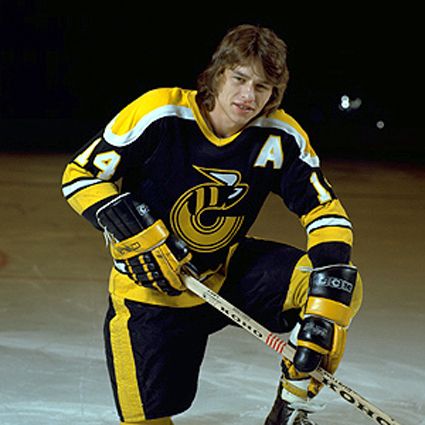 Sobchuk enjoyed the best years of his career with the Stingers
Sobchuk enjoyed the best years of his career with the Stingers
Once they had a completed home, they reclaimed Sobchuk, his brother Gene Sobchuk and Hughes and set out to fill their roster. They were led in scoring their first season by former Buffalo Sabre Rick Dudley, who led the team with 43 goals (leading the club by 11) and 81 points in 74 games. In one memorable day, the Stingers were scheduled to play
the Minnesota Fighting Saints, only the Houston Aeros came out to face
them because Minnesota had folded that day!
Leading scorer Dudley opted for a headband rather than a helmet
leaving little doubt this was the 1970'
The club finished with a respectable 35-44-1 record and only missed out on the playoffs by 2 points. Their 71 points were 12 more than the Edmonton Oilers, yet it was Edmonton that somehow managed to qualify for the postseason thanks to a quirk in the system in the always off-beat WHA.
The 1975-76 Cincinnati Stingers
For the 1976-77 season, Blaine Stoughton jumped to the
Stingers, who had obtained his rights from the Nordiques in the WHA
expansion draft. The move to the free wheeling WHA was a revelation
for Stoughton, who teamed with Dudley and Leduc to form the high powered "LSD Line".
Stoughton and Leduc each had 52 goals to finish fourth in the league,
with Leduc's 107 points 7th overall and Stoughton's 104 good for 9th,
while Dudley reached 88. Sobchuk was right behind the lead pair with 96 points to place 10th in WHA scoring right behind Stoughton.
Blaine Stoughton
The club finished in second place in the Eastern Conference with a team record 83 points, but were eliminated in the first round of the playoffs. That season also saw the debut of future NHL head coach and TV commentator Barry Melrose on defense. Following the season a proposed WHA merger with the NHL that would have included the Stingers was defeated by a single vote.
The 1977-78 season saw one of the more unusual jersey related occurrences in hockey history when Robbie Ftorek joined the club after the demise of the Roadrunners. Current team veteran Claude Larose had worn #8 for the past two seasons and Ftorek had also been wearing #8 as a tribute to former Boston Bruin Fleming Mackell. Neither wanted to relinquish their favorite number, so they had the team petition the league and permission was granted for both players to wear #8 during the season!
The 1977-78 Cincinnati Stingers
Ftorek went on to lead the club in scoring by a wide margin with 109 points, well clear of new team captain Dudley's 71. Ftorek's 59 goals were third overall in the WHA. In the standings, the Stingers finished seventh in the one-division now shrinking WHA, two points out of the playoffs.
Cincinnati Stingers team captain Dudley
Ftorek again led the team in points in 1978-79 with 116, while Peter Marsh was tops in goal scoring with 43. New and notable additions to the Stingers roster included goalie Mike Liut and future 700 goal scorer an Hockey Hall of Famer Mike Gartner.
Goaltender Mike Liut
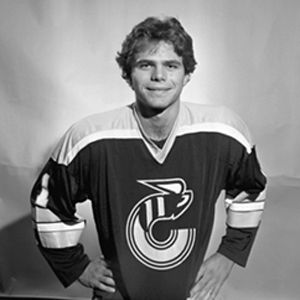 Mike Gartner as a Stinger in 1978-79
Mike Gartner as a Stinger in 1978-79
Also notable on the Stingers roster in 1978-79 was eventual six-time Stanley Cup winner and Hockey Hall of Famer Mark Messier, who failed to impress with a lone goal in 47 games. Three seasons later he would score 50 for the Edmonton Oilers in the NHL.
Messier got off to an inauspicious start with the Stingers
The Stingers finished the season in fifth place out of the surviving six teams, as the Indianapolis Racers folded after 25 games. Rather than have the top four teams play for the championship, Cincinnati was paired with the fourth place New England Whalers in a best of three series to determine who would join the top three clubs in Round 2.
The Whalers won Game 1 by a score of 5-3 in Hartford. Game 2 in Cincinnati saw the club win their one and only playoff game in team history 6-3 in front of their home fans. In the decisive Game 3, the Whalers prevailed by a score of 2-1 to eliminate the Stingers in what would prove to be the final game in franchise history on this date in 1979.
Following the season, the WHA agreed to a one-sided merger plan with the NHL, which allowed Winnipeg, New England, Quebec and Edmonton to join the NHL as expansion franchises, while the owners of both Cincinnati and the Birmingham Bulls were given a cash payment of $3.15 million as a buy-out, putting an end to the Stingers franchise after just four years on the ice.
Today's featured jersey is a 1977-78 Cincinnati Stingers Rick Dudley jersey.
With the Stingers name lending itself to a multi-stripe theme, it's a
wonder the Stingers jerseys were as reserved as they were. The club wore essentially the same jerseys for their all-to-brief
four year run, with the only change worth mentioning being changing from two color
names for their first two seasons to one color names for their
final two.
Dudley's name on a contrasting nameplate was unique to
the era until recently revived as a throwback element by the
Philadelphia Flyers.
In addition,
the filled-in outline around the captain's "C" is not something seen in
the NHL, while it has been used in various other leagues on occasion.
A favorite part of the Stingers jerseys is the crest, an
effective piece of graphic design that has stood the test of time with
flying colors.
Bonus jersey: Today's bonus jersey is a 1977-78 Cincinnati Stingers Robbie Ftorek jersey. Or is it a Claude Larose jersey?
In
a story that could only come from the wacky WHA, LaRose was the
Stingers leading scorer at the time they acquired the league MVP Ftorek,
formerly of Phoenix - and both wore the #8. The Stingers appealed to
the league and were granted permission to have both players wear #8 - at
the same time!
Since the nameplate was removed from
this jersey, there's no way to be certain short of photomatching, which
one of Ftorek or Larose wore this particular #8 jersey. Larose was
traded to the Racers after 51 games of that season,
leaving Ftorek's to wear #8 all by himself for the remainder of his time
in Cincinnati.
Extra bonus jersey: Today's extra bonus jersey is a
1978-79 Cincinnati Stingers Michel Dion jersey. This yellow home jersey is from the Stingers final season when one color names were used and serves to illustrate that the Stingers never had a white jersey, as they always played in gold at home.
Extra extra bonus jersey: Today's extra extra bonus jersey is a
1976-77 Cincinnati Stingers Blaine Stoughton jersey. This jersey is from the Stingers first two seasons when two color names were used.
Our first video is a profile of former Stinger Stoughton.
Here is amateur footage of the minor league Cincinnati Clyclones playing while wearing Stingers throwback jerseys.

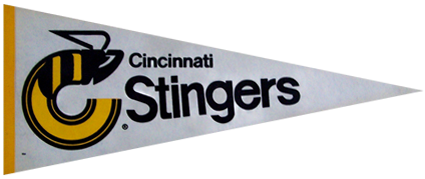




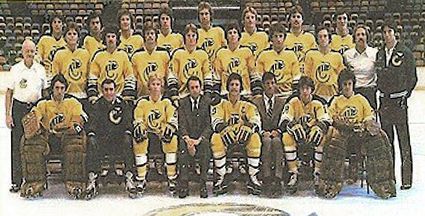
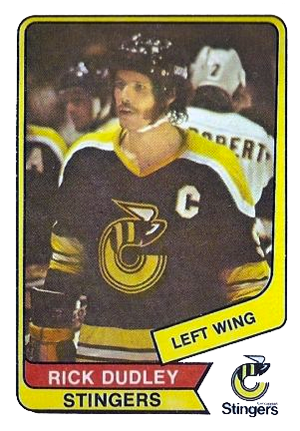
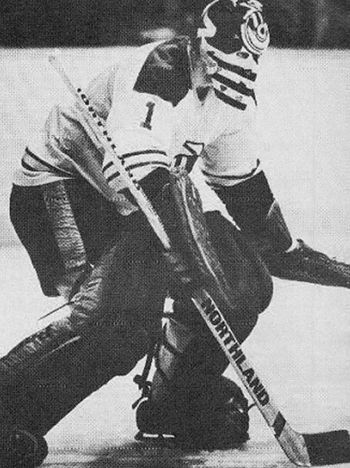

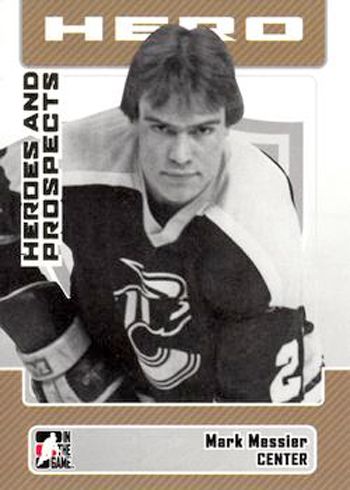
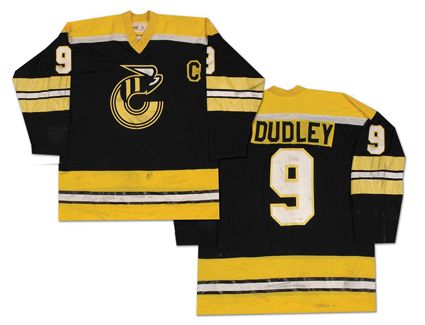
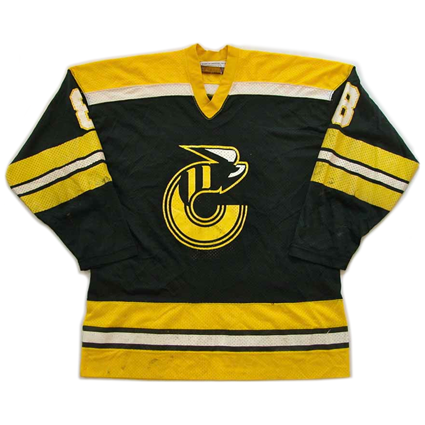
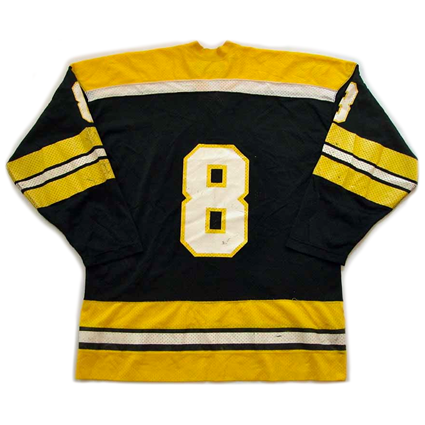
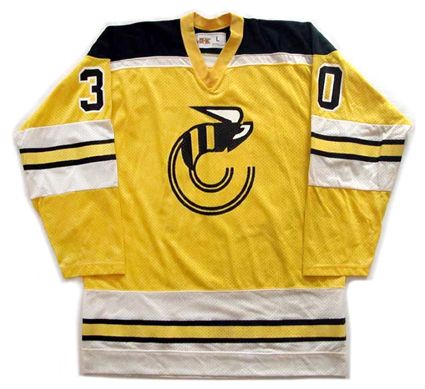
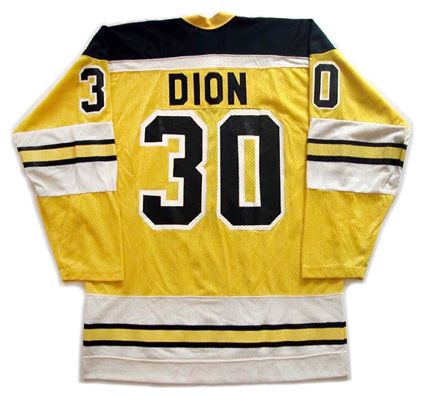
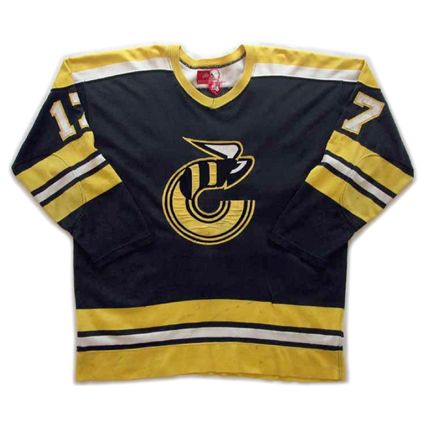
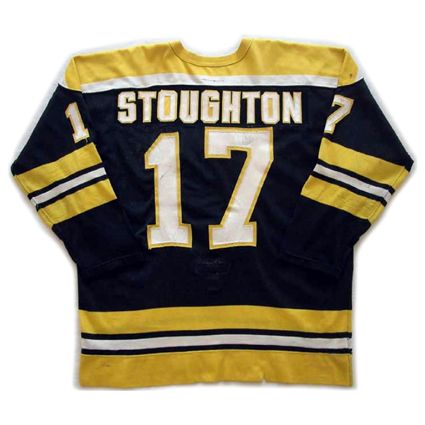










No comments:
Post a Comment
We welcome and encourage genuine comments and corrections from our readers. Please no spam. It will not be approved and never seen.